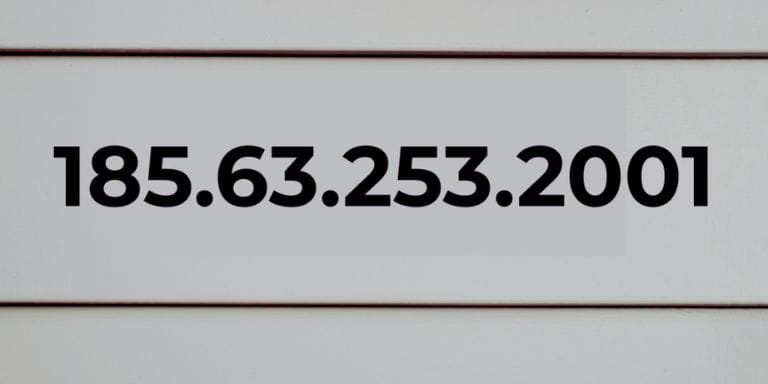185.63.253.2001 — Powerful Insights Into IP Address Security
The sequence 185.63.253.2001 looks like an IP address, and many users search for similar numeric strings online to identify servers, troubleshoot connections, or learn about networking. But what exactly does an IP address mean, and how can you interpret numbers like this?
This guide explains the basics of IP addresses, how they are structured, common mistakes in writing them, and how businesses and individuals can use IP lookup tools to improve security and troubleshooting.
What Is an IP Address?
An IP address (Internet Protocol address) is a unique numeric label assigned to every device connected to a computer network. It allows devices to find, connect, and communicate with each other.
There are two primary formats:
- IPv4: Uses four sets of numbers (0–255), separated by dots (example:
185.63.253.200). - IPv6: Uses eight groups of alphanumeric characters, separated by colons (example:
2001:0db8:85a3::8a2e:0370:7334).
👉 The string 185.63.253.2001 appears to combine both styles, which makes it not a valid IPv4 but looks somewhat like an IPv6 fragment. This is why it often confuses users when typed into browsers or network tools.
Why Do People Search for “185.63.253.2001”?
- Troubleshooting Connections – Users might type an IP when diagnosing issues with a website or server.
- Server Lookups – IT professionals often copy/paste logs with IP addresses for geolocation or abuse checks.
- Security Research – IPs can be flagged in cybersecurity reports, prompting searches for context.
- Learning About Networking – Students and beginners often test random addresses while exploring how the internet routes traffic.
How to Tell If an IP Is Valid
- An IPv4 address must have four numbers, each ranging from 0–255. Example:
185.63.253.200. - Anything outside that range, like “2001” in the fourth block, is not valid IPv4.
- If you see a number resembling “2001,” it might belong to an IPv6 block, which is written very differently.
Quick Check Tools
- WHOIS lookup – Finds ownership and registration info.
- IP geolocation services – Estimates where an IP is located.
- Ping & traceroute – Test whether a host is reachable.
Security and Privacy Considerations
Searching or interacting with unknown IP addresses should be done carefully. Some best practices include:
- Never click random IP links without knowing the source.
- Use a VPN to protect your real IP when researching addresses.
- Check security databases (AbuseIPDB, VirusTotal) if you suspect an IP is malicious.
- System admins: Monitor unusual IPs in logs to detect intrusions.
Educational Example: From 185.63.253.200 to IPv6
If we rewrite 185.63.253.2001 properly, two interpretations exist:
- IPv4 version:
185.63.253.200 - IPv6 sample:
2001:0db8:85a3::8a2e:0370:7334
This shows why it’s important to distinguish formats: IPv4 is running out of space, while IPv6 provides almost limitless addresses.
How IT Professionals Use IP Analysis
- Network admins: Track abnormal login attempts.
- Marketers: Analyze traffic origins.
- Teachers: Use IPs as real-world examples in networking classes.
- Cybersecurity experts: Trace attacks and blocklists.
Final Thoughts
The search for 185.63.253.2001 reflects the curiosity people have about IP addresses and online infrastructure. While this exact number is not a valid IPv4 address, it offers a great opportunity to understand how IP addressing works, how to check if an IP is legitimate, and how IT professionals use IP lookups for both troubleshooting and security.
For businesses, students, or curious internet users, learning about IP formats (IPv4 vs. IPv6) helps reduce errors, strengthen cybersecurity, and improve technical confidence.
FAQs About 185.63.253.2001
Q1. Is 185.63.253.2001 a valid IP address?
No. The format resembles IPv4, but the last block “2001” is too high (IPv4 allows 0–255). It looks like a mistaken entry or part of an IPv6 sequence.
Q2. What’s the difference between IPv4 and IPv6?
- IPv4 uses four numbers (0–255), e.g.,
185.63.253.200. - IPv6 uses alphanumeric groups separated by colons, e.g.,
2001:0db8:85a3::8a2e:0370:7334.
IPv6 exists to handle the shortage of IPv4 addresses.
Q3. Why do people search for IP addresses like 185.63.253.2001?
People often search IPs to troubleshoot connections, identify servers, check for suspicious activity, or learn networking basics.
Q4. How can I check if an IP address is safe?
Use online tools like WHOIS lookup, IP geolocation services, or security databases (AbuseIPDB, VirusTotal). Always use caution when interacting with unknown IPs.
Q5. What should I do if I find an unusual IP in my logs?
System administrators should investigate with traceroute, check security reports, and, if needed, block the IP or report it to their hosting provider.
